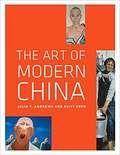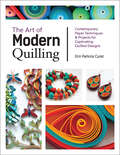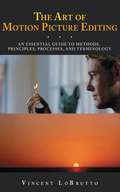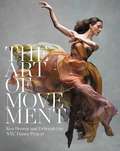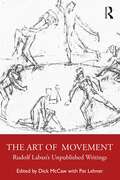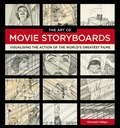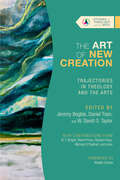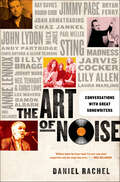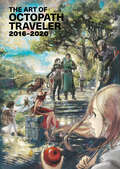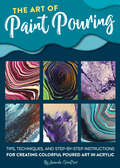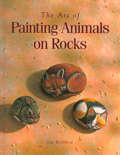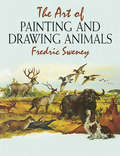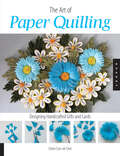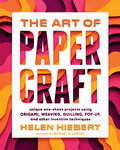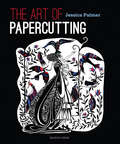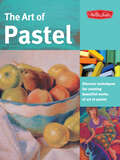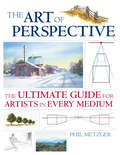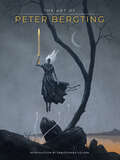- Table View
- List View
The Art of Modern China
by Julia F. Andrews Kuiyi ShenIn the early twenty-first century, China occupies a place on center stage in the international art world. But what does it mean to be a Chinese artist in the modern age? This first comprehensive study of modern Chinese art history traces its evolution chronologically and thematically from the Age of Imperialism to the present day. Julia Andrews and Kuiyi Shen pay particular attention to the dynamic tension between modernity and tradition, as well as the interplay of global cosmopolitanism and cultural nationalism. This lively, accessible, and beautifully illustrated text will serve and enlighten scholars, students, collectors, and anyone with an interest in Asian art and artists.
The Art of Modern Quilling: Contemporary Paper Techniques & Projects for Captivating Quilled Designs
by Erin Perkins CuretDiscover a modern twist on this traditional papercraft with innovative instruction and creative projects you will love to make and wear!Colorful strips of paper and a few simple tools are all you need to create an infinite number of amazing projects with author and quilling expert extraordinaire Erin Curet! Erin shows you a host of innovative techniques and provides plentiful inspiration in The Art of Modern Quilling.With Curet’s illustrated instructions, even first-time quillers be able to start creating modern paper crafts in no time. You’ll soon be making quilled jewelry, dazzling works of art, and colorful household items that are both practical and delightful.
The Art of Motion Picture Editing: An Essential Guide to Methods, Principles, Processes, and Terminology
by Vincent LobruttoLearn how to use images and sound to tell a motion picture story. This guide reveals how editing affects a motion picture's pace, rhythm, structure, and story, and spells out exactly what an editor does. The tools, methods, and processes of movie editing in any medium are revealed so that readers working with film, video, or digital equipment can apply the principles to all their work, from studio theatrical releases to short works for the Internet.Chapters cover the full language of editing, from composite shots and flash cuts to dissolves, reverse angles, and more, a well as various schools of editing thought, including Russian montage, cinema verite, avant-garde cinema, Italian neorealism, and Hollywood continuity. This complete resource blends the practical and philosophical aspects of film editing and includes unique features like a shot-by-shot analysis of landmark films, a detailed glossary of related terms, profiles of ten great editors, and a list of one hundred essential films that demonstrate top-notch editing work.
The Art of Mouse Guard 2005-2015: 2005 - 2015 Vol. 1 (Mouse Guard #1)
by David PetersenSince its debut in 2005, Mouse Guard has become a New York Times bestseller, Eisner-Award winner, and an influential staple of comics and sequential art. In honor of the ten-year anniversary of the series’ debut issue, The Art of Mouse Guard is a stunning celebration of the world, characters, and artistic process of David Petersen’s beloved series. An unprecedented look behind the scenes at the history, process, and art of the beloved, Eisner-Award winning series Mouse Guard, this title is an indepth look at the artistic and creative process behind the creation of the series and each volume of Mouse Guard.
The Art of Movement
by Ken BrowarA stunning celebration of movement and dance in hundreds of breathtaking photographs of more than 70 dancers from American Ballet Theater, New York City Ballet, Alvin Ailey American Dance Theater, Martha Graham Dance Company, Boston Ballet, Royal Danish Ballet, the Royal Ballet, and many more.The Art of Movement is an exquisitely designed, beautifully produced book that captures the movement, flow, energy, and grace of many of the most accomplished dancers in the world. These are the artists, from all walks of life, who are defining dance today. Here they are frozen in time in the most exquisite poses, and yet there's a feeling of movement in every photograph that makes the appear to be dancing across the pages. Accompanying the photographs are intimate and inspiring words from the dancers, as well as from choreographers and artistic directors, on what dance means to them. Dance is experiencing an unprecedented moment in popular culture. The Art of Movement is the perfect book for newly avid fans, as well as long-time lovers of dance.
The Art of Movement: Rudolf Laban’s Unpublished Writings
by Dick McCawThe Art of Movement: Rudolf Laban’s Unpublished Writings offers new perspectives on the thinking and practice of Rudolf Laban – one of the pioneers of modern European dance and movement analysis. A wealth of Laban’s previously untranslated writings broadens our understanding of his work through new perspectives on his thinking and practice. Alongside these key primary sources, interviews with Laban’s family and colleagues and editorial commentaries shed new light on the significance of his life and career. Laban’s own texts also offer further elaboration of the key themes of his work – eukinetics, choreutics, lay dance, pedagogy and dance notation. This essential companion to The Laban Sourcebook is an ideal resource for any students or scholars of modern dance, dance studies, dance history and movement analysis looking for a deeper understanding of this seminal figure in their field.
The Art of Movement: Rudolf Laban’s Unpublished Writings
by Dick McCawThe Art of Movement: Rudolf Laban’s Unpublished Writings offers new perspectives on the thinking and practice of Rudolf Laban – one of the pioneers of modern European dance and movement analysis. A wealth of Laban’s previously untranslated writings broadens our understanding of his work through new perspectives on his thinking and practice. Alongside these key primary sources, interviews with Laban’s family and colleagues and editorial commentaries shed new light on the significance of his life and career. Laban’s own texts also offer further elaboration of the key themes of his work – eukinetics, choreutics, lay dance, pedagogy and dance notation. This essential companion to The Laban Sourcebook is an ideal resource for any students or scholars of modern dance, dance studies, dance history and movement analysis looking for a deeper understanding of this seminal figure in their field.
The Art of Movie Storyboards: Visualising the Action of the World's Greatest Films
by Fionnuala HalliganThe unsung heroes of film, storyboard artists are the first to give vision to a screenplay, translating words on the page into shots for the screen.Their work is a unique art form in itself. Many storyboards are beautiful in their own right, but ultimately the skill of the artist lies in their visual communication of a script, with multiple factors to consider: composition, movement, camera angles, special effects, and the rhythm and pacing of a scene.The Art of Movie Storyboards celebrates this art, showcasing a vast collection of storyboards in a range of styles, and including some of cinema's greatest moments. The collection includes the work of pioneers such as William Cameron Menzies (Gone with the Wind) and Saul Bass (Psycho, Spartacus), as well as contemporaries such as Raúl Monge (Pan's Labyrinth) and Jane Clark (Harry Potter and the Goblet of Fire). Many are seen here for the first time, and all are accompanied by insights into the films featured, their directors, and, of course, the storyboard artists.
The Art of Natural Building
by Michael Smith Joseph F. Kennedy Catherine WanekThe popularity of natural building has grown by leaps and bounds, spurred by a grassroots desire for housing that is healthy, affordable, and environmentally responsible. While there are many books available on specific methods such as straw-bale construction, cob, or timber framing, there are few resources which introduce the reader to the entire scope of this burgeoning field.Fully revised and updated, The Art of Natural Building is the complete and user-friendly introduction to natural building for everyone from the do-it-yourselfer to architects and designers. This collection of articles from over fifty leaders in the field is now stunningly illustrated with over two-hundred full-color photographs of natural buildings from around the world. Learn about: The case for building with natural materials, from the perspectives of sustainability, lifestyle, and health What you need to know to plan and design your own beautiful and efficient natural home Explanations of thirty versatile materials and techniques, with resources on where to go for further information on each How these techniques are being used to address housing crises around the world. Clearly written, logically organized, and beautifully illustrated, The Art of Natural Building is the encyclopedia of natural building.Joseph F. Kennedy is a designer, builder, writer, artist, educator, and co-founder of Builders Without Borders.Michael G. Smith is a respected workshop instructor, consultant, and co-author of the best-selling book The Hand-Sculpted House.Catherine Wanek is a co-founder of Builders Without Borders and author/photographer of The Hybrid House and The New Straw Bale Home.
The Art of Neil Gaiman: The Story Of A Writer With Handwritten Notes, Drawings, Manuscripts, And Personal Photographs
by Neil Gaiman Hayley CampbellNovelist, comics writer, scriptwriter, poet, occasional artist - a master of several genres and inadvertent leader of many cults - there are few creative avenues Neil Gaiman hasn't ventured down. From unforgettable books like The Ocean at the End of the Lane and American Gods to ground-breaking comics and graphic novels like The Sandman and Violent Cases; from big screen fantasies like Coraline to small screen epics like Doctor Who; and from short stories to songwriting, stage plays to radio plays, journalism to filmmaking, and all points in-between, The Art of Neil Gaiman is the first comprehensive, full-colour examination of Gaiman's work to date.Author Hayley Campbell, a close friend of Neil's since she was a small child, spent many months rummaging through Neil's attic to source the never-before-seen manuscripts, notes, cartoons, drawings and personal photographs for this book; these are complemented by artwork and sketches from all of his major works and his own intimate recollections. Each project is examined in turn, from genesis to fruition, and positioned in the wider narrative of Gaiman's creative life, affording unparalleled access to the inner workings of the writer's mind.Utterly comprehensive, lavishly illustrated, The Art of Neil Gaiman is the fully authorised account of the life and work of one of the greatest storytellers of all time.
The Art of New Creation: Trajectories in Theology and the Arts (Studies in Theology and the Arts Series)
by Jeremy Begbie W. David O. Taylor Daniel Train, Jeremy Begbie, W. David O. Taylor Daniel TrainThe biblical themes of creation and new creation are inextricably bound to each other.
The Art of Noise: Conversations with Great Songwriters
by Daniel RachelTHE ART OF NOISE offers an unprecedented collection of insightful, of-the-moment conversations with twenty-seven great British songwriters and composers. They discuss everything from their individual approaches to writing, to the inspiration behind their most successful songs, to the techniques and methods they have independently developed to foster their creativity. Contributors include: Sting * Ray Davies * Robin Gibb * Jimmy Page * Joan Armatrading * Noel Gallagher * Lily Allen * Annie Lennox * Damon Albarn * Noel Gallagher * Laura Marling * Paul Weller * Johnny Marr * and many more Musician-turned-author Daniel Rachel approaches each interview with an impressive depth of understanding—of the practice of songwriting, but also of each musician's catalog. The result is a collection of conversations that's probing, informed, and altogether entertaining—what contributor Noel Gallagher called "without doubt the finest book I've ever read about songwriters and the songs they write." The collected experience of these songwriters makes this book the essential word of songwriting—as spoken by the songwriters themselves.
The Art of Octopath Traveler: 2016-2020
by Square EnixJourney across the fantastic world of Octopath Traveler with over 200 pages of concept art and developer commentary collected in a stunning hardcover volume!Join the travelers in their journey through Orsterra and discover each of their unique origins. Delve into a fantasy landscape full of amazing creatures and scenery. Ponder the inspired design and artistic passion—all through incredible art from the creation of the critically acclaimed Octopath Traveler and Octopath Traveler: Champions of the Continent.Dark Horse Books and Square Enix present The Art of Octopath Traveler, officially published in English for the first time! This localization of original Japanese material features gorgeous concept art and extensive commentary from the games&’ creative teams. Discover what lies beyond the horizon!
The Art of Orality: Cultural Aesthetics in the Absence of Writing
by Declan LloydThis book considers how the presence or absence of writing can influence a culture&’s distinctive styles of visual art, proposing that many of the most profound developments in the art world are directly correlative with a cultural transition from orality to literacy (that is, from a culture which only has a spoken form of language, to one which has both a spoken and written form). The study contemplates how the &‘psychodynamics&’ of orality might radically affect artistic expression, resulting in a range of visual traits which in many ways reflect the unique modes of speech within primary oral societies. Looking to the art of a diverse range of cultures and time periods – including Archaic Greek art, medieval art, African tribal art, child art, Outsider art and Modern art – The Art of Orality considers what new insights can be gleaned by bringing these styles into dialogue with orality and literacy studies.
The Art of Pacific Rim: The Black
by Andrew OsmondOfficial art book of Seasons 1 and 2 of the anime series Pacific Rim: The Black, featuring concept art created during the development of the series.The Art of Pacific Rim: The Black retraces Taylor and Hayley&’s dramatic odyssey from the perspectives of the talented producers, directors, writers and animators who created this immensely popular series. They provide fascinating insight into how the series came about, the development of the characters, the design of the Kaiju and Jaegers, and much more. This lush, coffee table hardback book is packed with stunning images from the series, including sketches, concept art and final renders. With an exclusive foreword from showrunner Greg Johnson and visuals covering Seasons 1 and 2, there has never been a better time to dive deeper into &‘The Black&’!
The Art of Paint Pouring: Tips, Techniques, and Step-by-Step Instructions for Creating Colorful Poured Art in Acrylic (Fluid Art Ser.)
by Amanda VanEverLearn the creative, innovative technique of making art by pouring paint with The Art of Paint Pouring. Featuring easy step-by-step projects, practical tips, and beautiful art from an established paint-pouring expert, this book helps artists of any skill level make colorful, textured art by pouring acrylic paint onto a canvas. There are many techniques for making poured art, and this book details them all. You will learn to swipe, pour, and more using the manyhow-to projects provided in this book. Also included are chapters on the following:Tools and materials, including affordable options for items that will help you create poured artBasic color theory and how to choose paint colors that will create pleasing mixturesEye-catching full-page artworkTips for creating the paint consistency that you wantInstructions for keeping your work area clean, even while working with a potentially messy techniqueWritten and illustrated by a well-recognized paint-pouring artist, The Art of Paint Pouring is a comprehensive reference that eliminates the need to search online for multiple videos that you would continually have to pause and re-watch. If you are new to paint pouring, you will love the beginners&’ tips and instructions that allow anyone to master this contemporary craft. Start creating stunning works of poured art with The Art of Paint Pouring. Also from the Fluid Art series, refresh your paint-pouring skills and learn new techniques with: The Art of Paint Pouring: Swipe, Swirl & Spin and The Art of Paint Marbling.
The Art of Painting Animals on Rocks
by Lin WellfordThis book holds a mountain of fun for rock artists of all ages! With the instructions inside, creating these critters is as easy as picking up a rock!
The Art of Painting and Drawing Animals (Dover Art Instruction)
by Fredric SweneyThousands of years after man first recorded his impressions of animals on cave walls, artists are still attempting to reproduce images of these incredibly diverse creatures of land, sea, and air. This book by an award-winning artist is designed to aid painters at all skill levels to draw and paint wildlife with precision and accuracy.Award-winning artist Fredric Sweney begins by using the horse as the basis for understanding the physical structure of animals, while the wild duck serves as the model for the configuration, wing construction, and flight characteristics of birds. More than 260 illustrations, along with step-by-step details, make it easier and more enjoyable than ever to paint a Noah's Ark of dogs, cats, oxen, deer, bears, birds, goats, and more exotic animals--in every size and shape. An invaluable guide to zoological anatomy, ideal for beginners as well as advanced artists, this complete, practical reference will also serve as an excellent resource for resolving commonplace problems of artistic composition.
The Art of Paper Quilling: Designing Handcrafted Gifts and Cards
by Claire Sun-ok ChoiA complete guide to the centuries-old papercraft that involves curling, coiling, and combining strips of paper into unique designs.With a focus on simple, elegant projects, The Art of Paper Quilling offers paper crafters a complete technique guide along with step-by-step project ideas for making beautiful framed pieces, cards, gifts, and more. The designs are all built upon simple rolled coils of paper that when grouped together, form intricate flowers, graceful butterflies, and delicate scrollwork. Quilled designs can be framed or used to embellish greeting cards, books and journals, and many types of simple paper structures. Claire Sun-ok Choi is an expert paper artist who has influenced the revival of this fanciful art form with her inspiring exhibits and internationally known books.
The Art of Papercraft: Unique One-Sheet Projects Using Origami, Weaving, Quilling, Pop-Up, and Other Inventive Techniques
by Helen HiebertPaper artist and teacher Helen Hiebert compiles a one-of-kind collection of 40 unique projects, each using just one sheet of paper. Combining decorative paper techniques like marbling, stamping, and stenciling with dimensional techniques like origami, cutting, folding, quilling, stretching, weaving, and pop-ups, The Art of Papercraft offers a rich variety of projects that will delight crafters, artists, and designers alike, including paper votive lights, pop-up cards, folded paper gift boxes and envelopes, woven paper wall hangings, miniature one-sheet books, and much more. Every project is beautifully photographed and accompanied by step-by-step visual instructions. Guidance on selecting tools, materials, and paper selection; in-depth technique instructions; and profiles of contributing paper artists make this a rich and practical celebration of papercraft. This publication conforms to the EPUB Accessibility specification at WCAG 2.0 Level AA.
The Art of Papercutting
by Jessica Palmer“An excellent mix of the practical and the inspirational . . . featuring the fantastic, Beardsley-like intricate arabesque designs of the author.” —The Papercraft Post BlogLearn how to separate the visual world into positive and negative shapes and design gorgeous images with pattern, texture and impact. A practical section shows step by step how to ‘draw with a knife’ safely and effectively. Then Jessica provides artistic insights into an inspiring selection of her paper artworks, including silhouettes, portraits, landscapes, fashion images, illustrations, life drawing and more.“Intermediate and advanced artists in search of a fresh technique will find this guide challenging and absorbing.” —Library Journal“Here she explains how to see the world through a paper cutter’s eyes. It’s all about seeing the positive and negative shapes in your subject, so the experience will stand you in good stead if you wish to improve your drawing skills.” —The Leisure Painter“Here are dozens of beautiful, inspiring papercuts.” —Machine Knitting Monthly
The Art of Pastel: Discover Techniques for Creating Beautiful Works of Art in Pastel
by Walter Foster Creative Team“Three accomplished artists each present an original take on the medium . . . This is a comprehensive guide for beginners.” —Library JournalThe velvety strokes of pastel have enchanted fine artists for more than a century. From airy strokes to bold marks and soft hues to vibrant shades, the versatility of pastel makes it suitable for a wide range of subjects and moods. Now anyone can experience this multi-dimensional medium with The Art of Pastel. Inside this comprehensive guide, three artists provide instruction for using soft, hard, and oil pastel—each sharing his or her unique approach. From portraits and landscapes to rich floral scenes, this book contains a wealth of inspiring images that artists can re-create step by step.
The Art of Peace
by Sir David KhaliliIn 1967, Sir David Khalili finished his military service in Iran and travelled to study in the United States with $750 - his remaining royalties from a book he wrote when he was just 14. Over the course of the next five decades he single-handedly, piece by piece, assembled eight of the finest art collections in their field, ultimately becoming one of the world's greatest collectors, about whom Queen Elizabeth II once said: 'It is scary how much this gentleman knows about art.'For the first time, Sir David shares his extraordinary journey: one that has taken him through the souks of North Africa, the auction houses of Europe and the United States, the bazaars of South Asia, and far beyond. Through a riveting collection of real-life adventures, he reveals his collecting strategy, business ethics and what motivates him to continuously collect, conserve, research, publish and exhibit the treasures in his collections. Through his story, Sir David questions how the undeniable power of art can be harnessed to foster greater peace and unity worldwide. No one is better placed to enlighten us.
The Art of Perspective: The Ultimate Guide for Artists in Every Medium
by Phil MetzgerEverything you need to know to put your drawings and paintings into perspective! If the concept of perspective makes you think of confusing angles, fancy measuring gadgets and complicated theories, get ready for a very pleasant surprise. In this comprehensive guide, Phil Metzger demystifies perspective, presenting it simply as a matter of mimicking the way we see--like the way a distant mountain appears blue, or a road seems to narrow in the distance. The Art of Perspective offers simple but powerful techniques for achieving a convincing illusion of depth and distance, whether it's a few inches in a still life or miles in a landscape. Start simple, with atmospheric perspective and intuitive techniques, and gradually progress to linear perspective and more complex challenges such as stairways, curves and reflections. Use the engaging, step-by-step demonstrations and exercises to try out each essential concept for yourself, making lessons clearer and more memorable. Learn theories that apply to all mediums, with specific advice for achieving effects using acrylic, oil, watercolor and pencil. Get the inside scoop on professional tricks and shortcuts that make perspective easier than ever! Forget everything you think you know (or don't know) about perspective. This book builds an easy-to-follow, ground-up understanding of how to turn a flat painting or drawing surface into a living, breathing, dimensional scene that lures viewers in. No matter how you look at it, it's the ultimate guide to perspective for artists of every medium and skill level.
The Art of Peter Bergting
by Peter BergtingExplore the dark, mystical, and mysterious work of Peter Bergting, collected for the first time in a gorgeous hardcover volume with an introduction by award-winning horror writer and longtime collaborator Christopher Golden!Bergting&’s repertoire of fantasy, horror, and sci-fi illustrations include comics, magazines, novels, and games, and he&’s worked in collaboration with creative giants like Mike Mignola. Award-winning comics artist and illustrator Peter Bergting showcases a body of work nearly 30 years in the making!
